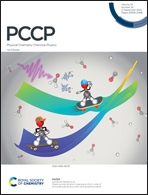Selenylation to charge transfer improvement at the counter electrode (CE)/electrolyte interface for nanocrystalline Cu1.8S1−xSex CEs†
Abstract
Pt counter electrodes (CEs) have been widely used in dye-sensitized solar cells (DSSCs) due to their high conductivity and electrocatalytic activity. However, industrialization of DSSCs is limited by shortcomings of Pt CEs such as being expensive, and weak corrosion resistance in electrolytes. Reported in this paper is two simple approaches to Pt-free Cu1.8S1−xSex CEs. Nanocrystalline Cu1.8S1−xSex CEs were fabricated via two processes, that is, a solvothermal process to Cu1.8S1−xSex powder followed by CE fabrication, and a solvothermal process and CE fabrication to Cu1.8S films followed by selenylation to Cu1.8S1−xSex CEs. Photoelectric conversion efficiencies (PCE) of 4.02% and 4.16% were achieved respectively by the as-fabricated Cu1.8S1−xSex CEs. Compared with the cells with Cu1.8S CEs fabricated by the same processes, increases of 19% and 45% were achieved, respectively. The PCE improvement comes from the enhancement of charge transfer at the CE/electrolyte interface induced by the selenylation of the CEs.



 Please wait while we load your content...
Please wait while we load your content...